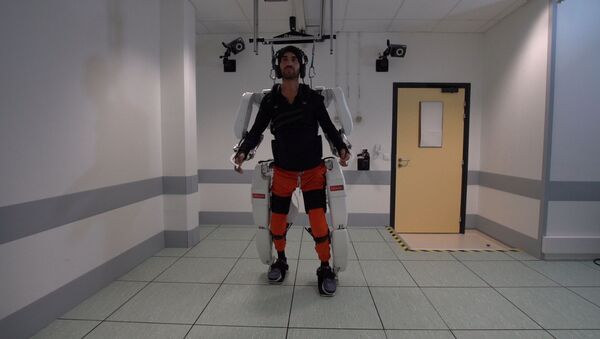A report published in The Lancet Neurology journal on Thursday revealed groundbreaking developments in the field of neuroscience and encouraging progress in restoring mobility to those paralyzed due to spinal injuries.
The patient, identified only as Thibault, is a 28-year-old man from Lyon who was diagnosed with tetraplegia and lost complete mobility in his arms and legs following a traumatic cervical spinal cord injury at a nightclub.
In footage recently recorded at the Clinatec research center in Grenoble, France, Thibault is seen suspended by a ceiling harness for safety as he uses brain signals to communicate with his exoskeleton, moving his legs forward and arms up.
“When you are in my position, when you can’t do anything with your body … I wanted to do something with my brain,” Thibault said, according to an interview with AFP. “I can’t go home tomorrow in my exoskeleton, but I’ve got to a point where I can walk. I walk when I want and I stop when I want.”
In order to begin the clinical trial, researchers implanted two bilateral wireless epidural recorders over his brain’s upper limb sensorimotor areas and proceeded to perform a number of tasks to decode his brain signals and produce an algorithm for the exoskeleton.
Data collection and a series of mobility tests continued from June 12, 2017, to July 21, 2019, and Thibault has reportedly been able to walk a total of more than 100 meters.
"[This] is the first semi-invasive wireless brain-computer system designed ... to activate all four limbs," Alim-Louis Benabid, a co-leader of the study, neurosurgeon and University of Grenoble professor, told Reuters. He went on to explain that previous research relied on the patient or subject to have the receptors direct implanted into their brain, but in Thibault’s case, the receptors are located between his brain and skin.
“This isn’t about turning man into machine, but about responding to a medical problem,” Benabid told AFP in another interview. “We’re talking about ‘repaired man,’ not ‘augmented man.’”
While the progress made by researchers and Thibault is a major advancement in robotics and neuroscience, Tom Shakespeare, a professor at the London School of Hygiene and Tropical Medicine, informed Reuters that “proof of concept is a long way from usable clinical possibility.”
"A danger of hype always exists in this field. Even if ever workable, cost constraints mean that high-tech options are never going to be available to most people in the world with spinal cord injury,” he added. The price tag of this long-term research was not published with the results, but it is noted that various foundations, the French Atomic Energy Commission, French Ministry of Health, Institut Carnot and Clinatec all funded the study.
Nevertheless, Thibault is optimistic about the future and says the results from the trial offer a “message of hope to people like me … This is possible, even with our handicap.”


